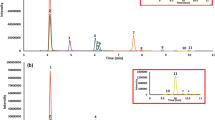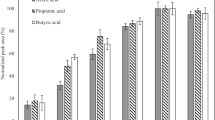Abstract
Short-chain fatty acids (SCFAs) are the main gut microbe metabolites, which have no more than six carbons. SCFAs are an emerging biomarker in metabolic diseases, including central obesity. Commonly, SCFAs are measured in fecal samples, where they are highly abundant, but here they do not reflect direct interactions with related organs. Serum SCFAs are assumed to be more associated with metabolic disease than fecal SCFAs, albeit at very low concentrations. The aim of the present study is to develop a highly sensitive, simple, and fast method for measuring six SCFAs in the serum by gas chromatography–mass spectrometry (GCMS). The serum is mixed with meta-phosphoric acid and 2,2-dimethylbutyric acid, followed by homogenization and centrifugation. Supernatant is then injected into the fused silica capillary column. The method is linear from 0.12–500 μmol/L for all SCFAs with an accuracy of 90–117%. The total coefficient of variation for precision ranges from 3.8 to 14.1%. A preliminary study is performed with 32 centrally obese subjects and 17 lean subjects. The mean values of all SCFAs, including acetic, propionic, isobutyric, butyric, isovaleric, and valeric acid, in the centrally obese subjects are significantly higher compared with lean subjects. A significant correlation also exists between all SCFAs, with the waist circumference indicating that serum SCFAs have potential features with respect to metabolic diseases, especially central obesity. The validated GCMS method provides highly sensitive, fast, simple, and reliable SCFA quantitation in the serum and demonstrates the potential features of circulating SCFAs in central obesity.



Similar content being viewed by others
Data availability
The authors declared that the data supporting the findings of this study are available within the article.
Code availability
Not applicable.
References
Parada Venegas D, De la Fuente MK, Landskron G, González MJ, Quera R, Dijkstra G, et al. Short chain fatty acids (SCFAs)-mediated gut epithelial and immune regulation and its relevance for inflammatory bowel diseases. Front Immunol [Internet]. 2019 Mar 11;10. Available from: https://www.ncbi.nlm.nih.gov/pmc/articles/PMC6421268/. Accessed 18 Nov 2019.
Rios-Covian D, González S, Nogacka AM, Arboleya S, Salazar N, Gueimonde M, et al. An overview on fecal branched short-chain fatty acids along human life and as related with body mass index: associated dietary and anthropometric factors. Front Microbiol. 2020;11:973.
Ribeiro WR, Vinolo MAR, Calixto LA, Ferreira CM. Use of gas chromatography to quantify short chain fatty acids in the serum, colonic luminal content and feces of mice. Bio-Protoc. 2018;8(22):e3089.
den Besten G, van Eunen K, Groen AK, Venema K, Reijngoud D-J, Bakker BM. The role of short-chain fatty acids in the interplay between diet, gut microbiota, and host energy metabolism. J Lipid Res. 2013;54(9):2325–40.
Chambers ES, Preston T, Frost G, Morrison DJ. Role of gut microbiota-generated short-chain fatty acids in metabolic and cardiovascular health. Curr Nutr Rep. 2018;7(4):198–206.
Markowiak-Kopeć P, Śliżewska K. The effect of probiotics on the production of short-chain fatty acids by human intestinal microbiome. Nutrients [Internet]. 2020 [cited 2020 Sep 21];12(4). Available from: https://www.ncbi.nlm.nih.gov/pmc/articles/PMC7230973/
Guinan J, Wang S, Hazbun TR, Yadav H, Thangamani S. Antibiotic-induced decreases in the levels of microbial-derived short-chain fatty acids correlate with increased gastrointestinal colonization of Candida albicans. Sci Rep. 2019;9(1):8872.
Li X, Guo J, Ji K, Zhang P. Bamboo shoot fiber prevents obesity in mice by modulating the gut microbiota. Sci Rep [Internet]. 2016;6. Available from: https://www.ncbi.nlm.nih.gov/pmc/articles/PMC5013436/. Accessed 21 Sept 2020.
de la Cuesta-Zuluaga J, Mueller NT, Álvarez-Quintero R, Velásquez-Mejía EP, Sierra JA, Corrales-Agudelo V, et al. Higher fecal short-chain fatty acid levels are associated with gut microbiome dysbiosis, obesity, hypertension and cardiometabolic disease risk factors. Nutrients [Internet]. 2018;11(1). Available from: https://www.ncbi.nlm.nih.gov/pmc/articles/PMC6356834/. Accessed 21 Sept 2020.
Soldavini J, Kaunitz JD. Pathobiology and potential therapeutic value of intestinal short-chain fatty acids in gut inflammation and obesity. Dig Dis Sci. 2013;58(10):2756–66.
Jakobsdottir G, Bjerregaard JH, Skovbjerg H, Nyman M. Fasting serum concentration of short-chain fatty acids in subjects with microscopic colitis and celiac disease: no difference compared with controls, but between genders. Scand J Gastroenterol. 2013;48(6):696–701.
Pouteau E, Rochat F, Jann A, Meirim I, Sanchez-Garcia J-L, Ornstein K, et al. Chicory increases acetate turnover, but not propionate and butyrate peripheral turnovers in rats. Br J Nutr. 2008;99(2):287–96.
Zhang S, Wang H, Zhu M-J. A sensitive GC/MS detection method for analyzing microbial metabolites short chain fatty acids in fecal and serum samples. Talanta. 2019;196:249–54.
Kim H, Kwon J, Choi SY, Ahn YG. Method development for the quantitative determination of short chain fatty acids in microbial samples by solid phase extraction and gas chromatography with flame ionization detection. J Anal Sci Technol. 2019;10(1):28.
Deroover L, Boets E, Tie Y, Vandermeulen G, Verbeke K. Quantification of plasma or serum short-chain fatty acids: choosing the correct blood tube. J Nutr Health Food Sci [Internet]. 2017;5(6). Available from: https://symbiosisonlinepublishing.com/nutritionalhealth-foodscience/nutritionalhealth-foodscience112.php. Accessed 19 Sept 2020.
Moldoveanu SC, David V. Derivatization methods in GC and GC/MS. In: Kusch P, editor. Gas chromatography - derivatization, sample preparation, application [Internet]. IntechOpen; 2019. Available from: https://www.intechopen.com/books/gas-chromatography-derivatization-sample-preparation-application/derivatization-methods-in-gc-and-gc-ms. Accessed 19 Sept 2020.
Liebisch G, Ecker J, Roth S, Schweizer S, Öttl V, Schött H-F, et al. Quantification of fecal short chain fatty acids by liquid chromatography tandem mass spectrometry—investigation of pre-analytic stability. Biomolecules. 2019;9(4):121.
Chan JCY, Kioh DYQ, Yap GC, Lee BW, Chan ECY. A novel LCMSMS method for quantitative measurement of short-chain fatty acids in human stool derivatized with 12C- and 13C-labelled aniline. J Pharm Biomed Anal. 2017;138:43–53.
Robards K, Robards K, Haddad PR, Haddad PR, Jackson PE, Jackson PE, et al. Principles and practice of modern chromatographic methods. Academic Press; 1994. 509 p.
Tolley HD, Tolley SE, Wang A, Lee ML. Moving thermal gradients in gas chromatography. J Chromatogr A. 2014;1374:189–98.
Wei X, Koo I, Kim S, Zhang X. Compound identification in GC-MS by simultaneously evaluating mass spectrum and retention index. Analyst. 2014;139(10):2507–14.
Meesters RJW, van Eijk HMH, ten Have GAM, de Graaf AA, Venema K, van Rossum BEJ, et al. Application of liquid chromatography–mass spectrometry to measure the concentrations and study the synthesis of short chain fatty acids following stable isotope infusions. J Chromatogr B. 2007;854(1–2):57–62.
Polson C, Sarkar P, Incledon B, Raguvaran V, Grant R. Optimization of protein precipitation based upon effectiveness of protein removal and ionization effect in liquid chromatography–tandem mass spectrometry. J Chromatogr B. 2003;785(2):263–75.
Hoving LR, Heijink M, van Harmelen V, van Dijk KW, Giera M. GC-MS analysis of short-chain fatty acids in feces, cecum content, and blood samples. Methods Mol Biol Clifton NJ. 1730;2018:247–56.
College of American Pathologist. Chemistry and toxicology checklist. College of American Pathologist; 2016.
Clinical & Laboratory Standards Institute. C62-A: liquid chromatography-mass spectrometry methods; approved guideline. :88.
Clinical & Laboratory Standards Institute. C50-A: mass spectrometry in the clinical laboratory: general principles and guidance; approved guideline. 112.
Nicholson JK, Holmes E, Kinross J, Burcelin R, Gibson G, Jia W, et al. Host-gut microbiota metabolic interactions. Science. 2012;336(6086):1262–7.
van Hoek MJA, RMH M. Redox balance is key to explaining full vs partial switching to low-yield metabolism. BMC Syst Biol. 2012;6:22.
Topping DL, Clifton PM. Short-chain fatty acids and human colonic function: roles of resistant starch and nonstarch polysaccharides. Physiol Rev. 2001;81(3):1031–64.
Müller M, Hernández MAG, Goossens GH, Reijnders D, Holst JJ, Jocken JWE, et al. Circulating but not faecal short-chain fatty acids are related to insulin sensitivity, lipolysis and GLP-1 concentrations in humans. Sci Rep. 2019;9(1):1–9.
Zhao G, Nyman M, Jönsson JÅ. Rapid determination of short-chain fatty acids in colonic contents and faeces of humans and rats by acidified water-extraction and direct-injection gas chromatography. Biomed Chromatogr. 2006;20(8):674–82.
Schwiertz A, Taras D, Schäfer K, Beijer S, Bos NA, Donus C, et al. Microbiota and SCFA in lean and overweight healthy subjects. Obesity. 2010;18(1):190–5.
Rahman MN, Diantini A, Fattah M, Barliana MI. Nutritional biomarkers for predicting pancreatic beta cell failure in central obesity. Indones Biomed J. 2021;13(1):19–26.
Funding
This research was funded by grants-in-aids from Prodia Clinical Laboratory Post Graduate Scholarship for MNR.
Author information
Authors and Affiliations
Contributions
MR and MB: literature review and manuscript drafting and revision; MB, AD, MF: conceptualization and design, proofreading and editing, and critical revision; MB, AD, MF: proofreading and supervision. All authors have read the manuscript and provided final approval.
Corresponding author
Ethics declarations
Ethics approval
All procedures performed in this study was approved by Health Research Ethics Committee of Faculty of Medicine Universitas Padjadjaran (No. 1039/UN6.C.10/PN/2017).
Source of biological material
The biological material was human serum, which was obtained from a stored biological samples from a previous study in 2017.
Conflict of interest
The authors declare no competing interests.
Additional information
Publisher’s note
Springer Nature remains neutral with regard to jurisdictional claims in published maps and institutional affiliations.
Rights and permissions
About this article
Cite this article
Rahman, M.N., Diantini, A., Fattah, M. et al. A highly sensitive, simple, and fast gas chromatography–mass spectrometry method for the quantification of serum short-chain fatty acids and their potential features in central obesity. Anal Bioanal Chem 413, 6837–6844 (2021). https://doi.org/10.1007/s00216-021-03639-3
Received:
Revised:
Accepted:
Published:
Issue Date:
DOI: https://doi.org/10.1007/s00216-021-03639-3




